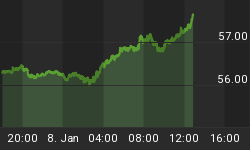Each month the Bureau of Labor Statistics attempts to estimate how many jobs were created (or eliminated) by smaller businesses not yet included in its survey of employers. This estimate is referred to as the "birth/death" adjustment. In the 12 months ended June, total-not-seasonally-adjusted nonfarm payrolls increased by 1.982 million. During the same interval, the birth/death adjustment contributed 1.111 million jobs to the total. That is, in the 12 months ended June, the birth/death adjustment accounted for 56.0% of the 12-month increase in total nonfarm payrolls.
What has been happening to the relative contribution of birth/death estimates as the economy has slowed in the past year? The chart below shows that it has been rising. In the 12 months ended March 2006, the birth/death adjustment was contributing only 30.9% of the jobs to the change in nonfarm payrolls. The birth/death relative contribution has been trending higher since then. Notice that as the birth/death contribution to nonfarm payrolls has been trending higher, the percentage of small businesses saying that now is a good time to expand their operations has been trending lower. If existing small business managers do not think now is a good time to expand their operations, does it make sense that there are a lot of new small businesses starting up and hiring?
Chart 1
Perhaps because the birth/death adjustment is not, itself, adjusted for the phase of the business cycle the economy is in, it is biasing upward the growth in nonfarm payrolls now. Perhaps the birth/death adjustment is the answer to the Fed's latest conundrum with regard to stronger-than-expected payroll growth given the sharp slowing in real GDP growth.
















